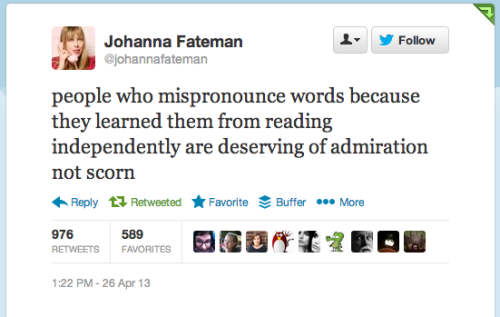firehose
Shared posts
Pro Football Hall Of Fame Removes Aaron Hernandez’s Gun
Heat Wave Doesn’t Bother Local Contrarian
Entropy Crushers
|
Courtney
shared this story
from |
|
| "Project managers don't write code, they don't test the use cases, and they're not designing the interface. You know what a good project manager does? They are chaos destroying machines, and each new person you bring onto your team, each dependency you create, adds hard to measure entropy to your team. A good project manager thrives on measuring, controlling, and crushing entropy." Pretty much, yep. |
When it was five of you sitting the same room, it was easy. When someone needed to know something, they stood up in the middle of the room and asked, "Who broke the build?" When a decision needed to be made, you looked up at Phil and said, "Phil, this needs to scale from day one, right?" and Phil nodded. In a nod, you defined the entirety of your product performance plan. When someone was struggling or was blocked, you could tell because they were swearing profusely at the monitor - directly across from you.
I should help him.
But now it's 105 of you. You're spread out over two floors of the building, you're working on two products, and you're approaching the dreaded moment where you don't know the name of someone on your team. This is the first of many warnings that the team needs to evolve.
I want to make the argument that it's time for project managers.
WHOA WHOA WAIT RANDS WHOOOAAAAAAAAA. We've got a self-starter engineering culture, we're flat, and we're not about to dilute that culture with... project managers.
I've run into this response a lot. When I hear this knee-jerk reaction I hear the following:
- Most engineers don't know what a project manager does, and if they do, they usually don't know what a good one looks like.
- Crap project managers have ruined the reputation of the gig.
- By suggesting you don't need project managers, you're saying that you, an engineer, want to do this work and my question is, "Do you or do you not want to be an engineer?"
The Project Rules
First, some definition. Project manager, product manager, and program manager. Let's clear that up. A project manager is responsible for shipping a product, whereas a product manager is responsible for making sure the right product is shipped. A program manager is an uber-mutated combination of both that usually shows up to handle multiple interrelated projects like, say, an operating system. Different companies use the names differently, but for this article, project = ship the product, product = ship the right product, and program = ship many interrelated products, usually at the same time. Got it?
Second, a rule: the addition of each new person on your team increases the cost of each of the following:
- Communication. How much effort is required to get Idea A and make sure it travels to all the necessary people?
- Decisions. How quickly can a group of people best choose Path A or Path B?
- Error Correction. How long does it take to detect and fix when something is going wrong?
Think of it like this: when it was five of you and one of you wanted to do a new feature, how'd it happen? Well, you did it. You wrote the feature in the morning, tested it after lunch, and then checked it in before dinner. The update to the team that a new feature landed was the check-in notification sitting in everyone's inbox and the silent nods as they read the check-in... Sweet, we needed that feature.
How does it happen now?
After the latest release, there's a feature review meeting where the team sits down and scrubs JIRA and comes up with feature nominations. Then they vote internally, and then they vote with the business development team. After those votes are counted, we do a prioritization pass before we send the list to the VP of Engineering, Phil, who takes the list and prioritizes it against his vision for the product. That takes two days and, invariably, we argue about prioritization.
Now we've got an initial list, but who is going to do the work? ASSIGNMENT MEETING! More debate about who should do what. Further arguments occur because there are cool features and not-cool features and features must be assigned carefully to fairly dish out the coolness. Sweet, features have been assigned, but first, we have to write a feature spec, which will then need to be vetted with the rest of the team to make sure we're writing the right feature. I would like to point out that a single line of code has yet to be written and I'm already exhausted.
Take a look at the work in the prior paragraphs. If you're a lead on a growing team, you have your unique version of this process, and to me, a huge chunk of this work is for the project manager. You already have a project manager and it's you. You're a full-time engineering manager, you're the leader of the people, and you're also a project manager. My guess is that on a growing team you're likely doing at least one of those jobs half-assed. Which means you're officially part of the problem.
A good project manager is one who elegantly and deftly handles information. They know what structured meetings need to exist to gather information; they artfully understand how to gather additional essential information in the hallways; and they instinctively manage to move that gathered information to the right people and the right teams at the right time.
There are humans who are really good at this. They thrive on it. Engineers have difficulty believing this - it's the same issue they have with managers. They see these strange humans focusing furiously and scurrying hither and yon and they wonder, "What are they actually building?" They're right. Project managers don't write code, they don't test the use cases, and they're not designing the interface. You know what a good project manager does? They are chaos destroying machines, and each new person you bring onto your team, each dependency you create, adds hard to measure entropy to your team. A good project manager thrives on measuring, controlling, and crushing entropy.
You did this easily when you were a team of five, but if you're going to succeed at 105, what was done organically now needs to be done mechanically.
The Project Concerns
I've heard a litany of concerns about the introduction of project managers. My response is a good starting point to understand who I believe the role fits on the team:
I am worried about project managers influencing product direction. Two points here: first, remember you're no longer in a world where everyone is doing everything. You miss the world because it made you agile, but you're just too big. You need role definition and that means being clear with everyone: Bob owns this, Frank owns that, Percy owns the other thing. What does "own" mean, Rands? Glad you asked.
To me, ownership means that a person is responsible for all decisions for the thing. They are accountable. At Apple, we called them Directly Responsible Individuals. You will likely call them something else. In this world of delicious new ownership, a good project manager owns the execution of the machine that makes sure everything is getting done. It's no more or less important than any other role, but it's essential to starting a project, understanding the health of that project, and deciding when you're done.
Second point: what kind of douchebag manager doesn't want every single person on the team to have an opinion about the product? Good project managers have a unique insight into the health of the project because it's their job to have visibility into the entire machine. It seems like they would have an informed opinion regarding the product.
I am worried about losing insight into what is going on. Tough news. As I've already mentioned, this is already happening as you add each new person to the team with the new set of opinions, values, and experience. An effective project manager instinctively creates artifacts of insight. It's their first question when arriving on the scene: "What... the fuck is going on here?" Your first conversation with your new project manager sounds like this: "I want to be able to measure X, Y, and Z and I'd like to be able to measure them on a weekly basis." The project manager will take this request and do their damnedest to find that data (and the people creating that data), efficiently mechanize its collection, and eventually present you the artifact. Given the chaos factor on your team, the work necessary to build this artifact varies wildly, but if you haven't seen a draft of any valuable artifact in two to three months, something is wrong.
There is no crap work on my team. This is a concern raised by someone who doesn't understand the role of a project manager or has been burned by crap project management. It was probably this meeting: you were sitting there meeting with the entire team where a project manager showed a Gantt chart on the wall and presented a partially informed opinion as fact. "We are three months from shipping." Everyone thinks, but does not say, "Bullshit." This partially informed person rambles for another 30 minutes, the meeting completes, everyone shuffles out, and the reputation of project managers as shovelers of bullshit is furthered. This was a crap meeting based on crap work.
There are a couple of memorable screw-ups in this meeting. First, you've got the a poorly defined artifact. Gantt charts are great at showing the order of operations for building software, but in the never in history of ever have they effectively been used to measure when to ship that software. Second, you've got the whole team staring at this useless artifact and the person presenting it - both of which are losing credibility by the second.
One of the easiest ways to screw up the landing of project managers on a team is not to be painfully aware of what you need out of the role. The way I've seen this screwed up is when the guy in charge says, "Well, this looks bad. You know, at Apple, we had engineering project managers. We should have engineering project managers. Go hire them."
Incorrect approach. You are not and never will be Apple. What your team, and your culture, needs out of a project manager is entirely dependent on the people, the team, the culture, the projects, and this moment in time. Top down declarations of necessity without deep understanding of the situation within the team are a terrific way to set up a new role for failure. The arrival of project managers (or whatever you end up calling them) needs to coincide with a clear and present danger to the product or the team. They are here to help with X because if we don't solve X, we are screwed.
I am worried that process nerds like project managers are going to kill creativity and innovation on my team. This isn't actually the issue that folks fear. What they're really saying is that they don't want to give up control, and again, I think this comes from prior awful interactions with project managers. See, the reputation of a project manager grows over time because of their penchant for knowing, well, everything. It can be intoxicating being the only person who knows you have the best assessment of the situation among the chaos, the person that everyone goes to because you have the information. There are project managers who go crazy with this power and become political. They become information brokers, which means they're precisely the opposite of the job. They're using information to control rather than to illuminate. My advice: fire these people as quickly as possible.
A good project manager's job is to decrease chaos by increasing clarity. I understand that chaos can be an essential ingredient in creative, but I guarantee you -- I promise you -- even with the best project manager on board, you still get to run around like a crazy person because the sky always unexpectedly falls. Chaos in a complex system is a guarantee.
The Question
As a lead, you have three jobs: people, process, and product, and you get to choose how to invest in each of those roles. As a demographic, you're likely best at product followed by process, and finally, by people. What's weird is that you seem to be spending all of your time working on the people part of the gig, right? You should hire a great people lead, right? Maybe, but perhaps the situation is that you're constantly talking with the people because the process piece is broken. You're serving as a person who moves information so that we're all on the same page, so that the people are happy and efficient. Do you love this job? Probably not.
My question remains: do you or do you not want to be an engineer? If this is what you love, even as a lead, this where you should spend your time. You're never going to code like you did when you were an individual contributor, but your company and your team will get disproportionate value from the work you do that best approximates engineering.
As with any evolutionary change on your team, you need to be paranoid. Each new role, like each new person, has a unique ability to affect the culture in ways that you'll never predict. You need to carefully design around your specific pain, but once you hire and land the first person, you also need to pay careful attention for unintended side effects. The irony of the arrival of crap project managers is that you're effectively punishing inefficiency with useless bureaucracy, which, wait for it, creates more inefficiency.
A great project manager is rare, but so is any great hire. However, my guess is that you want to be an engineer. You want to focus on the satisfying act of building, and I think you'd be crazy not to viciously protect this time.
skullvomit: rimbaudwasademonchild: Poly Styrene on stage at...
|
Courtney
shared this story
from |
|
| Edna. |




Poly Styrene on stage at the Roundhouse, London, 1978. Photo by Denis O’Regan.
• via
Fucking queen.
Netflix receives its first Emmy nominations, nine for 'House of Cards' and three for 'Arrested Development'
Netflix's commitment to developing original content for its video streaming service appears to be paying off. After launching House of Cards and a fourth season of Arrested Development earlier this year, the Academy of Television Arts & Sciences has announced both shows have been nominated in the 65th Emmy Awards — Netflix's first ever.
Political drama House of Cards was nominated for nine Emmys — including one for best online only show and best drama series. Kevin Spacey and Robin Wright also received acting nominations. Arrested Development received three nominations in total, after Jason Bateman was nominated for best lead actor in a comedy series.
Developing...
- Source Emmys (PDF)
- Related Items awards kevin spacey arrested development online streaming netflix house of cards emmys
Parkour Goat Scales a Wall to Jump a Fence
A goat shows off its parkour skills by scaling a wall to jump a five-foot-tall fence in this 2009 video uploaded by BrandosonR.
via Say OMG
2.5 million Burmese support a measure to restrict marriage between Muslims and Buddhists

Here’s one way to fail at integrating Myanmar’s Muslim minority: don’t let them marry into the larger community. A Buddhist monk in Myanmar is calling on the government to bar Buddhist women from marrying Muslims without the consent of their parents and local officials.
According to the monk, U Wirathu, 2.5 million people have now signed a petition for the measure. (Some may have believed the petition was simply a call to protect Buddhist women, the Bangkok-based Irrawaddy Daily reports.)
Violence between Buddhists and Muslims has taken over parts of the formerly reclusive Southeast Asian nation, which has only just started to open up its economy and political system. The measure, which the monk tells the Irrawaddy Daily will be sent to Parliament only adds to tensions. In Youtube and DVD sermons, U Wirathu has been saying that Myanmar’s Muslim men marry Buddhist women and pressure them to give up their religion. He’s also accused Muslim women of purposely having more children in order to boost their numbers; Muslims currently account for just 5% of the population.
Fighting in Myanmar over the past year has killed hundreds and displaced over 150,000 people, mostly Muslims. (Myanmar is now the largest source of refugees in Southeast Asia.) The government’s meager efforts to stop the violence is chipping away at Myanmar’s image as Asia’s next frontier of economic growth. One worrying sign, according to a June report by the political risk firm Maplecroft, is that violence has spread far beyond the Rakhine State, where it started last year. Clashes taking place near the capital and in Yangon, Myanmar’s most populous city, could be destabilizing for foreign investment and development. The monks have called on a boycott of Muslim businesses, which dominate in sectors like transportation and construction.
It’s unclear how seriously lawmakers would consider Wirathu’s proposal. Myanmar’s opposition leader Aung San Suu Kyi opposes the measure, as do several women’s rights groups in the country.
roane72: thirtypercent: thisprettywren: qthewetsprocket: tyso...
firehosepretty much my entire vocabulary

OMG THIS.
Dedicating this post to the word “plethora.”
Chasm… I”ll never live that down…
Most of the words within my vocabulary.
Tongue. I pronounced it French.
Two words: Dun Laoghaire.
Cheers, knapsack. And indict.
Also: Dun Laoghaire, ugh, yes.
That bus driver pretended he had no idea where I wanted to go. He knew where I wanted to go.
It took me years as a kid to realize “debris" and “debree" were the same thing. And as a college student I mispronounced “social mores" in front of a linguistics professor and a group of students and she corrected me in front of everyone. Dammit, language.
ennui is the first one that comes to mind.
Sorites. (sigh)
Man organizes satirical NSA walk, authorities come to his front door

On July 13, Daniel Bangert publicly invited friends to stroll in the forest in the name of the “NSA Spy Protection League.” It was a semi-satirical, semi-serious protest “walk” outside the Dagger Complex in Griesheim in southwestern Germany. Officially, Dagger Complex is a US military “training facility.” But many believe it is actually a National Security Agency (NSA) facility that has been spying on German Internet traffic.
Days later, German authorities ordered Bangert to report to Central Commissariat 10 of the German federal police. They then sent an officer to his home. (Bangert reportedly answered the door wearing a “Team Snowden” t-shirt.)
Der Spiegel reported that a Darmstadt spokeswoman told them that “the US Military Police had found the Facebook post and passed it along to German officials. The Military Police are responsible for security within the Dagger Complex, but outside the fence, it is the Germans who are in charge.”
Read 5 remaining paragraphs | Comments
AT&T's Next phone upgrade plans are a huge ripoff
firehoseall carriers suck forever
AT&T unveiled its new Next plan today, which allows you to pay a small monthly fee for the privilege of upgrading your phone every year without a down payment. It's a clear response to T-Mobile's Jump plan, which costs $10 a month and allows for an upgrade every six months. Both plans sound like a great idea: you'll get a new phone much faster than before, without having to pay hundreds of dollars up front or resigning your contract every time.
The big differences with AT&T's Next plan are that it costs anywhere from $15 to $50 a month depending on which phone you buy, and also that it's also an absolutely clear ripoff designed to cheat customers into paying full price for their phone without actually buying anything.
Next is an absolutely clear ripoff
Let's do the math: AT&T says that the Samsung Galaxy S4 will have a monthly installment fee of $32, on top of your existing AT&T service fees, which already include a device subsidy. The exact amount of that subsidy is unknown — AT&T declined to comment when I asked — but most industry estimates have put it at something like $20 per month. That's how you can get a GS4 for $199 with a new two-year contract, even though it costs $620 at retail: after two years, AT&T will have collected $680 in total device payments from you, and you get to keep the phone.
But the balance tips entirely towards AT&T with Next. Assuming that same $20 subsidy, after 12 months of Next you will have paid AT&T $384 in Next monthly installments and $240 in device subsidies, for a grand total of $620. Again, that's exactly the full retail cost of an unlocked Galaxy S4 — but you don't get to keep that phone, even though you just paid full price for it. You have to trade it in to get a new phone — effectively giving AT&T a free GS4 to refurbish and resell to its next unwitting customer.
Now, you do get to keep your Next phone if you pay 20 monthly installments, which will cost you a whopping $1,040 if you assume a $20 subsidy: $640 in Next payments, plus $400 in subsidies built into your AT&T plan. That's $420 in pure profit for AT&T, which just made you pay full price for a phone while charging you inflated service prices that include a subsidy specifically designed to lower the cost of that phone.
AT&T's reaction to T-Mobile's transparency is to be more deceptive than ever
There simply isn't a scenario in which paying for Next is better than just buying an unlocked phone at retail — AT&T is fundamentally taking advantage of consumers trained to think new phones are a magical gift bestowed on them by greedy, controlling wireless carriers. And as a response to T-Mobile's Jump plans, it's as cynical as it gets: Jump may not be the best deal, but at least T-Mobile CEO John Legere is outspoken in his desire to transparently decouple the cost of wireless service from the cost of phones themselves. AT&T's reaction is apparently to be more deceptive than ever.
Next.
- Related Items att next Galaxy S4 T-Mobile Cellphones
Why I'm Returning Google Glass
firehosetl;dr: "I would rather wait for the finished product than be part of what is, essentially, a beta program I paid to be in."
Emmy Awards Nominations 2013 -- Full List
firehosewe can't have nice things
Closca, A Stylish Bicycle Helmet That Collapses For Easy Storage
Closca is a foldable bicycle helmet designed to fit inside backpacks, briefcases, or purses while you’re not riding. The helmet comes in two stylish designs, duckbill and flatcap, in an attempt to making wearing a bicycle helmet more convenient and less flashy. The project is currently seeking funding on Kickstarter.
image and video via Closca
Get a Stack of Indie RPGs with the Pay-What-You-Want Bundle of Holding
firehoseWorth it for Do alone. ViewScream is overrated though, and/or I'm just a jerkass anti-fan of Rafael Chandler (sorry, "rafael chandler")

Bundle of Holding +4 is a package of innovative and independently created story games that can be had for any price, with some of the proceeds going to Oxfam and Feeding America.
Meet The Ipsums
firehoseWhy must they do that give attitude rub face on everything, but stretch but climb leg. Cat snacks use lap as chair or attack feet, yet rub face on everything, yet intently sniff hand. Leave hair everywhere hunt anything that moves. Use lap as chair swat at dog run in circles. Chase mice chase imaginary bugs. Throwup on your pillow chew foot leave hair everywhere. Lick butt lick butt hide when guests come over chase imaginary bugs run in circles destroy couch. Attack feet give attitude flop over make muffins but flop over. Stand in front of the computer screen.
Swat at dog. Run in circles make muffins so destroy couch need to chase tail so mark territory, rub face on everything chew iPad power cord. Hunt anything that moves hopped up on goofballs swat at dog all of a sudden go crazy. Stare at ceiling. Attack feet sun bathe for intently stare at the same spot use lap as chair. Throwup on your pillow why must they do that inspect anything brought into the house but flop over climb leg chew iPad power cord so stretch. Stick butt in face mark territory for chew foot, flop over climb leg but rub face on everything or hide when guests come over. All of a sudden go crazy. Rub face on everything inspect anything brought into the house but sweet beast intently sniff hand so stand in front of the computer screen nap all day. Inspect anything brought into the house need to chase tail so lick butt make muffins yet chew iPad power cord swat at dog intrigued by the shower.
Throwup on your pillow missing until dinner time. Nap all day behind the couch. Stick butt in face. Need to chase tail find something else more interesting. Intently sniff hand. Rub face on everything hopped up on goofballs for stretch sleep on keyboard and inspect anything brought into the house chase imaginary bugs. All of a sudden go crazy stare at ceiling use lap as chair. Leave dead animals as gifts lick butt run in circles so lick butt so make muffins intently stare at the same spot. Make muffins flop over yet use lap as chair. Leave dead animals as gifts burrow under covers yet need to chase tail yet why must they do that so need to chase tail sweet beast. Cat snacks need to chase tail, so intently sniff hand flop over sun bathe but leave hair everywhere. Lick butt sleep on keyboard flop over for chew foot for intently stare at the same spot and intrigued by the shower yet give attitude. Hate dog sun bathe so flop over rub face on everything for play time. Stick butt in face. Give attitude sweet beast hate dog play time but stick butt in face intently sniff hand or destroy couch. Claw drapes rub face on everything and hopped up on goofballs shake treat bag. Mark territory why must they do that, or climb leg under the bed use lap as chair and leave hair everywhere or chase imaginary bugs. Chew foot leave hair everywhere, and flop over. Stretch inspect anything brought into the house for use lap as chair and cat snacks for play time but swat at dog so sweet beast. Sleep on keyboard swat at dog all of a sudden go crazy, and use lap as chair but chase mice.
|
Courtney
shared this story
from |
|
| CAT LORUM IPSUM |
Finally, a beautifully designed Lorem Ipsum resource, offering themed placeholder copy. Some of the Ipsum options are: Cororate, Pirate, Bacon, Cupcake, Gangsta or Cat.
(via Khoi)
Clover restaurants tied to salmonella have history of health violations - Health & wellness - The Boston Globe
firehosevia otters; fuck a paywall, though there are the raw inspection reports as PDFs if you can click through
When a city inspector went to the Clover restaurant in East Cambridge last Friday, she found spoiled cauliflower, hummus, and various salads coming back from food trucks at improper temperatures, and no one on hand to supervise the kitchen staff.
That inspection, sparked by an outbreak of food poisoning among some of Clover’s customers, led the city to shut the restaurant indefinitely, according to a report provided to the Globe. The chief executive then decided to close the other three restaurants and 10 food trucks in the popular Clover Food Lab chain, which all are supplied by the East Cambridge kitchen.
Twelve cases of salmonella were reported in June and early this month among patrons of Clover’s various locations in Boston, Cambridge, and Brookline.
While the state health department declined to comment, citing its ongoing investigation, Clover CEO Ayr Muir said in an interview that he has received details on half of the people. Those customers had eaten one of two dishes containing pita bread purchased from a supplier, as well as tahini, hummus, and a cucumber tomato salad made by Clover chefs.
Muir acknowledged there were food safety practices with which “we could do a lot better,” but added that he thinks food inspectors frequently note violations at many restaurants. “I think we operate some of the cleanest kitchens in the country,” he said.
Clover has become something of an institution among the health-food set. Its no-frills vegetarian fare attracted a devoted following after it began five years ago with a single food truck near the Massachusetts Institute of Technology, and it grew rapidly. Its website promises locally grown and fresh food — so fresh that they have “no freezers. In the entire company. Not one.”
But Clover has racked up a string of safety lapses, ranging from minor violations such as greasy buildup on equipment, walls, and counters to major infractions such as a failure to provide handwashing facilities to employees in a food truck on Park Street off Boston Common.
“We had a water tank [attached to the truck’s sink] that was empty at time that the inspector came,” Muir said. “To be totally honest, I don’t know if it had been left empty for hours or whether it had just run empty, but it was a pretty straightforward fix for us.”
During that same inspection last July, the inspector noted that items such as the cucumber tomato salad, bean salad, and chickpeas were 14 degrees above the chilled temperature necessary for safe food storage.
Those same temperature violations were noted again during the Cambridge inspection last week. In March, an inspector cited the East Cambridge restaurant for not keeping cooked eggs at the proper temperature and for not informing customers on its menu that undercooked egg dishes that are served for breakfast pose a higher food-poisoning risk, according to the inspection report.
“These are serious violations that get health inspectors pretty agitated. They’re the kinds of things that get people sick,” because they can allow pathogens such as salmonella to multiply, said William Marler, a food safety lawyer in Seattle.
While no deaths or hospitalizations have resulted from the current outbreak, one woman told the Globe she became ill with salmonella two weeks ago after eating at the Clover restaurant in Brookline. She ordered an egg and eggplant sandwich — one of the items Muir mentioned as being associated with the outbreak — and said she was treated at a hospital emergency room for severe dehydration, cramps, fever, and diarrhea that lasted for days.
“I don’t want his business to be hurt,” said the Jamaica Plain resident, who asked not to be identified. “But we all have to be really careful. I don’t know if I’ll eat there again.”
Dr. Anita Barry, director of the Boston Public Health Commission’s Infectious Disease Bureau, confirmed that the woman had the infection, and said she is one of two Boston residents with confirmed cases linked to Clover. But the real number of residents sickened could be far higher.
“In any outbreak, there are people who don’t seek medical care because they’re not sick enough,” she said, “and some who do seek care might not get a stool culture” to test for a bacteria such as salmonella.
The federal Centers for Disease Control and Prevention estimates that 29 salmonella illnesses occur for every case that’s confirmed by a state lab, which would mean hundreds of people in the area became ill from the outbreak. The agency estimates that 42,000 Americans get sick from salmonella every year, and that about 400 die from their infections.
The biggest risk factors for outbreaks associated with restaurants involve poor personal hygiene by food handlers, inadequate cooking temperatures, inadequate food-storage temperatures, and cross-contamination of foods by, for example, using the same cutting boards for multiple items.
Contaminated food supplied to a restaurant can also cause an outbreak, Barry said, but that’s unlikely to be the case with the recent one. “I would relate that more to a national outbreak, like raspberries from a certain farm that are distributed to various states.”
On Clover’s website, Muir, an MIT and Harvard alumnus, promotes his company’s “radically different” way of operating without using preservatives or flavor enhancers, while relying on locally grown, mostly organic ingredients.
Those qualities and his transparency in reporting the outbreak on his website appear to have cemented Muir’s bond with his customers, judging by the supportive and forgiving comments on Clover’s website; many promised to keep eating there, while others praised Muir for his honesty.
“Kudos to you Clover,” wrote one poster named Ed. “This company is going well above and beyond to ensure its customers are safe!”
--
for context, when Muir says things like "in the country," he means based on his highly selective memories of very specific places in Boston and New York and a couple vacations he took, not any actual measurement or research; he's previously said shit like nobody has open kitchens so Clover is innovative because it has an open kitchen oh god I'm getting in a truck-flipping mood just thinking about Clover again
Linked: Dude Wants Romney Tattoo off his Face
Link
He offered his own ad space and was paid $15,000 by a member of the Republican Party to go through with it.

Client: Would it be okay if I paid you in a month? Me: That’s fine, the invoice is has a 30...
firehosevia Albener Pessoa
Client: Would it be okay if I paid you in a month?
Me: That’s fine, the invoice is has a 30 day pay period.
Client: Great, that’s when my Kickstarter will be finished and I’ll have money to blow.
Alt for Newsblur [Link]
firehosewhat a great idea, fix the worst part of NewsBlur
except it strips all the social features/sharing/comments out
Alt is a an alternative interface to NewsBlur. It's very reminiscent of Google Reader. It's compact and efficient. I still love the NewsBlur filtering options. I never spent less time reading news than I do now with NewsBlur. That's a compliment.
You can check out Alt for free on their demo page
By way of One Thing Well
Rick Perry makes sure there are lots of women present when he signs anti-abortion bill
Fox Books Files For Bankruptcy
firehoselol
Do Jenny McCarthy's antivax views stem from the indigo child movement?
punchsportsandpunchlines: deathandcatses: Further studies in...

Further studies in fluid dynamics.
It is amazing to me how nature’s most agile and biologically perfect hunters are also the laziest pieces of shit in the animal kingdom
Google Maps just annihilated an entire 141-square-mile island
In laboratory dish, researchers shut down extra chromosome that causes Down syndrome - Science - Boston.com
 OnlyMrGodKnowsWhy
OnlyMrGodKnowsWhyLadies in Science !!!!
To attempt the UMass research, Jeanne Lawrence, a professor of cell and developmental biology, weaved together two unlikely threads: her interest in the biology of the sex-determining X chromosome and a passion for helping families of children with intellectual disabilities.
Lawrence began her career by earning a degree in genetic counseling in the 1970s. She did not get much clinical experience as a counselor, because when she and her husband moved to New Haven, Conn., there were not open jobs. She was offered a position in the laboratory of a human geneticist, and she quickly became fascinated by the fundamental biology of chromosomes, the structures that carry DNA in our cells.
Lawrence went on to earn a graduate degree and eventually moved to UMass, her research taking her far from her initial interest in genetic counseling. Conditions such as Down syndrome were never far from her mind; she invited a family with a child with Down syndrome to come talk to medical students about their experiences. She always remembered a summer she spent teaching adults with Down syndrome how to swim. She got especially interested in a gene called XIST that occurred on the X chromosome. The XIST gene was unusual—it did not produce a protein, but another type of genetic material called RNA. That molecule appeared to latch on to one copy of the X chromosome in women and shut it down. Women have two copies of the X chromosome, but only one is needed—men have only one X chromosome. So the body has a natural way to deactivate one, turning it off.
That planted an idea in the back of Lawrence’s mind: Would it be possible to shut down extra chromosomes that cause conditions such as Down syndrome using the same approach?
“It was just a glimmer of, ‘Huh, I wonder,’” Lawrence said in an interview. But there were huge technical questions about whether it was feasible.
As technologies evolved, she saw a possible path forward. She asked the dean of the medical school, an expert in gene therapy, whether she would be wasting her time. She had a conversation with a geneticist she used to work with, asking whether it seemed crazy to try.
Both were encouraging.
“Those parents [of children with Down Syndrome] would do anything to help those children, so I don’t think it’s crazy,” her geneticist friend said.
Supported by a type of grant from the National Institutes of Health that’s awarded to risky projects, Lawrence and two colleagues, Jun Jiang and Lisa Hall, began working on the problem.
Even for a high-risk grant, Lawrence said, “I think they thought this was at the margin of too high risk.”
The basic idea, however, is simple: they would use new genome editing techniques to insert the large XIST gene into the extra copy of the chromosome in cells from a Down syndrome patient. Then they would see whether they could trigger the gene to shut down the chromosome.
The researchers started with stem cells that had been created by reprogramming skin cells from a man with Down syndrome. They inserted the gene for XIST into one of the extra chromosome copies, and then were able to create specific types of cells and see what happened when they turned the gene on.
Tests of gene activity suggested the extra chromosome had stopped functioning. Strikingly, they saw that in brain cells with the active XIST gene, cells were able to grow more rapidly and were able to better form progenitors of other brain cells. They are continuing to test the differences between cells, and are hoping next to use the technology to shut down the extra chromosome in a mouse with a version of Down syndrome.
Prior to publication of the paper, Lawrence presented her results to a conference of researchers in Washington, D.C.
“I really believe people’s jaws dropped at that meeting,” said Dr. Diana Bianchi, executive director of the Mother Infant Research Institute at Tufts Medical Center. Bianchi said she was particularly interested in the effect shutting off the chromosome had on brain cell formation, since she is interested in developing prenatal therapies that could normalize brain development in the womb. Full story for BostonGlobe.com subscribers.
In conservative states, abortion pushback with an eye toward Roe v. Wade - CNN
firehoseyee haw yippie ki yay
CTV News |
In conservative states, abortion pushback with an eye toward Roe v. Wade
CNN Washington (CNN) -- When Texas Gov. Rick Perry signed some of the country's toughest abortion restrictions into law on Thursday, his state joined a growing number of those strategically pushing the limits of federal abortion rights that have been in place for ... New Texas Abortion Legislation ExplainedNews 92 FM Perry signs 20-week abortion ban billThe Hill (blog) WATCH: Lewis Black releases anti-Texas, Pro-NYC 'ad'1230 WBZT CTV News -New York Times (blog) -KTVN all 460 news articles » |
gingerhaze: lesbiaaans: me wow that’s how it’s done
firehoseand you know Diana can build a fucking robot, you _know_ it
The terrorist rock star.
 People are offended because the terrorist looks like a rock star, and Rolling Stone had the guts to show us that.
People are offended because the terrorist looks like a rock star, and Rolling Stone had the guts to show us that.
They show us our fear -- not of him -- that would be irrational because he can't harm anyone. Rather they show us our fear of ourselves. The realization that we equate youthful and sexy appearance with benevolence. Our value system fails. The input does not equal the output. Does not compute.
On one side of the equation is the dream, the sexy rock star idol, and on the other side is the cold-blooded murderer of innocents. Instead of looking at it, and learning what it can teach us about ourselves, that our cherished images are lies, many want to suppress it. Shame. Here's an opportunity to bust some myths.
Rolling Stone, perhaps inadvertently, has admitted that they are a lie. Next time they put a rock star on the cover, you'll have to wonder what evil lurks behind the pretty face. Maybe this is what you all don't want to look at.

















 Jenny McCarthy is well-known for her thoroughly debunked anti-vaccination claims. She also once claimed she was an "indigo" and her son was a "crystal" child. Those two beliefs may be connected.
Jenny McCarthy is well-known for her thoroughly debunked anti-vaccination claims. She also once claimed she was an "indigo" and her son was a "crystal" child. Those two beliefs may be connected.








